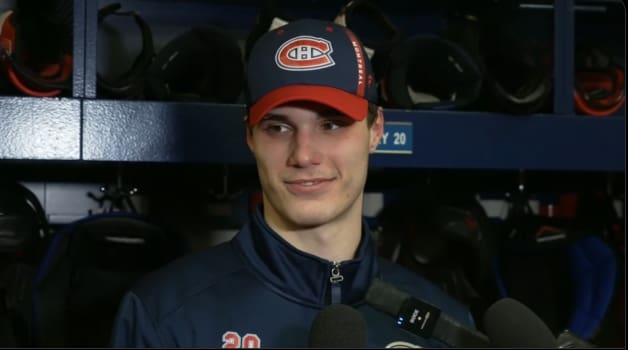Montreal Canadiens
Montreal Canadiens Nearing Difficult Decision With Slafkovsky

At the quarter mark of the 2022-23 season, Montreal Canadiens rookie Juraj Slafkovsky finds himself in a delicate situation.
His season has begun with a heavy dose of peaks and valleys, including a suspension and some missed games due to an upper-body injury.
Slafkovsky was forced to leave the game early in Saturday’s game against Chicago, following a hit that led the Slovak forward to undertake a concussion test.
He left the game midway through the third period, which certainly played a part in his season-low 7 minutes and 53 seconds of ice time, or roughly a dozen shifts.
He’s incredibly young and Martin St-Louis is taking a slow approach, which is to be applauded given Slafkovsky is overflowing with raw talent but lacks the experience to put all his skills together in an efficient manner.
However, Saturday was not the first time Slafkovsky has been given an underwhelming amount of ice time. His usage varies between 10 and 17 shifts per game, which has resulted in a very low average ice time, even when compared to other rookies throughout the organization.
The List
As it stands, the following forwards were given more ice time with the Montreal Canadiens than Slafkovsky during their rookie seasons. The NHL only started keeping records of TOI in 2005-06:
Eric Chouinard, Daniel Carr, Tom Pyatt, Lars Eller, Louis Leblanc, Maxim Lapierre, Andrei Kostitsyn, Kyle Chipchura, Mikhail Grabovski, Jake Evans, Jesse Ylonen, Blake Geoffrion, Alex Galchenyuk, David Desharnais, Guillaume Latendresse, Max Pacioretty, Philip Danault, Max Ribeiro, Duncan Milroy, Sven Andrighetto, Tomas Plekanec, Nikita Scherbak, Cole Caufield, Marcel Hossa, Jesperi Kotkaniemi, Jacob de la Rose, Jiri Sekac, Charles Hudon, Arturri Lehkonen, Brendan Gallagher, Chris Higgins, Sergei Kostitsyn, Nick Suzuki, Michael Ryder, Matt D’Agostini, and Rem Pitlick.
Of course, you could argue that some of those players deserved more ice time, especially when discussing older forwards, players such as Suzuki, Pacioretty, and Lehkonen, but the fact remains in the last 16 seasons, 36 forward rookies have received more average ice time than Slafkovsky, and none of them were chosen first overall at the NHL Draft.
There are always different factors to consider.
Strength of the team, the ability of the player to absorb a high amount of information in a short period, maturity, chemistry, and available ice time.
And there are still some clear red flags in Slafkovsky’s game, such as his tendency to put himself in bad positions, which leads to questionable hits.
“With my body, I shouldn’t be receiving those hits,” he said. “Sometimes that happens. Maybe I should read the situation better. It happened quickly though.”
Slafkovsky, who is always rather harsh when evaluating his performance, gave an honest answer when asked how his season has unfolded so far.
“It’s been alright. Nothing special, nothing too bad. Just average. I have to step up. I’m trying to learn every game. I feel like there’s been ups and downs. I don’t even have 20 games. Last year I was playing Junior, I was in Finland. It’s a big jump. I’m happy that I can learn how to play in this league and don’t have to go through minors and stuff. I feel great that I can be here and I’m trying to do my best to improve every day.”
Seeing as he’s on the fourth line, he’ll have ample opportunities to improve his awareness on the ice when it comes to physical play, but there are very few other learning opportunities in his current role.
And that’s the crux of the issue.
Seeking Confidence
As Martin St-Louis explained when discussing the usage of Kirby Dach in the shootout against the Blackhawks, it’s up to the coach to put players in positions that lead to building confidence.
“That’s part of the job as a coach,” said St-Louis. “It’s putting players in positions that are conducive to success. That’s how the players build confidence.”
There’s very little confidence to be built when playing 10 minutes per night on the fourth line with a rotating cast of linemates.
To St-Louis’ credit, he’s used Slafkovsky sparingly on the second power-play unit, but overall, Slafkovsky is not playing in a position that is conducive to success, conducive to building confidence.
His underlying numbers reflect a lack of confidence. Slafkovsky started with relatively strong possession metrics, but they have cratered in recent weeks.
If the goal is to develop the hulking forward into a game-breaking presence, there’s value to playing him alongside Montreal Canadiens players that can help him reach the next level, rather than slotting him with the 12th and 13th forward in the lineup.
Consistency is crucial and so is usage.
If Slafkovsky is expected to hit the scoresheet with a little more regularity and thus improve his confidence, he will need to be used in a situation that will make that outcome a little more likely.
To do that, he will need to take more shots.
To take more shots, he’ll need better linemates and more ice time.
The best way to gain valuable confidence in his case is not watching his teammates while only being given three or four shifts per period on any given night.
The World Junior Championship may present an interesting option when it comes to a mid-season confidence boost, though St-Louis remained tight-lipped when discussing the possibility.
“That’s not a question for me,” he said. “That’s a question for Kent.”
Regardless of whether he represents Slovakia in the upcoming tournament, if the Montreal Canadiens hope the youngest player in the NHL builds an identity brimming with confidence, they’ll need to figure out a better way than giving him minimal ice time on the fourth line.
We must also keep in mind general manager Kent Hughes is seeking value for many of his veteran wingers on the trade market, but the potential increase in returns should not be given precedence over the development of the first-overall pick at the 2022 NHL Draft.

